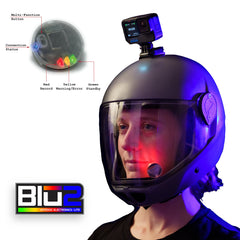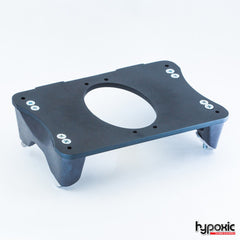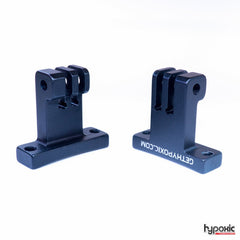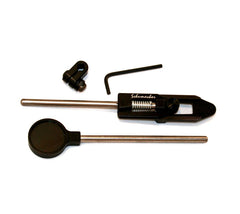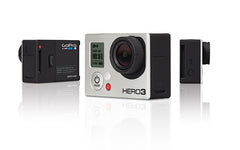Filming Bigways & Record Formation Skydives
Posted by Mark Kirschenbaum on
After filming a bigway skydiving record this weekend, I realized many of the techniques and methods we used are not documented anywhere. Some of these are my own, whereas others have been passed down from the masters. Although these techniques were used for a belly formation, they are basically the same for vertical formations.
It is imperative that videographers are knowledgeable with bigway formations before they film one. It's highly recommended to be a participant, or at least sit in on a few debriefs before just "sending it."
Remember: One mistake can have deadly repercussions
The purpose of this blog is to be a resource to newer bigway videographers. This is the culmination of what I've learned filming both belly and vertical formations.

Exit frame of a 76-Way from the right-right trail
Topics
Terminology
As a refresher:
Floaters are the first ones out of the plane and they float, or track up, to the formation. There are typically many more floaters in vertical formations than belly formations.
First row divers or "in the door" are the people somewhere in the middle.
Divers are the last ones out of the plane and they dive down to the formation.
Flivers are people who float up too far and become a diver. This is extremely dangerous as its blind to those who are diving. (Mainly a freeflier term)

The "stadium" of the formation building
Stadium The stadium is the tiered setup to approach to approaching the skydive. Basically one unit up for every one unit back you are from the formation. You can see in this image, most people are in the stadium but the person on the bottom right.
Your Job
As the videographer, you are an active participant. It's your job to safely capture the formation without creating any undue stress on it's participants or organizers. You're an important part of the team and therefore your job isn't only capturing the formation, but filling any gaps required to make the event a success. We have a unique vantage point, so bring up any safety concerns to the organizers when seen.
I like to find out exactly what the organizers want for the various views and angles. These needs typically change throughout the camp so its best to keep an ear open during the debrief for changes. During the warm up jumps, typically the organizers focus on the approach and the stadium view.

Formation plane naming conventions
During actual attempts the organizers focus more on the on the buildup and timing of the participants exiting the plane. Typically the videographer in the lead plane will focus on the base, and the other videographers will focus on the exits and maybe a slightly back and flat during the initial build.
For record attempts you need to see all the grips so steep views are better. For artsy shots, on level or flatter angles do show depth.

Flatter view where grips don't need to be seen. This view shows more depth on bigger formations but it's not judgeable.
Deliverables

Before the event I like to communicate my deliverables and when/how the media will be pushed to participants. I highly recommend getting media out as fast as possible so participants don't record the screens with their phones. Facebook is a common portal for event photos and Google Drive / Dropbox works well for video. Link sites like Linktr.ee work well to act as a intermediary so participants aren't looking everywhere. Similarly you can create a page on your website like I do with ultrastoked.com
Recently, I like posting short reels and stories as they get more traction with less work than an event video. But be sure to spell out and charge appropriately if a full edit is expected. Remember, it is typically another full day or two of work.
Copyright and ownership is a good discussion to have with the organizer. Generally, the photographer owns all copyright. Therefore explicit permission needs to be obtained by anyone using the images or video for commercial purposes. Yes this means even for the participant's sponsorships, hometown articles, or commercial blog posts.
For the past few years, low resolution video and photos are distributed online. Remind participants they are for personal use only, and not for print. Participants can reach out to the individual videographer for prints and commercial releases.
The last note I would give is, the organizers confide around you about problem participants. It is not your job to divulge this information and it's imperative that you keep this to yourself.
My goal at each of these events is "don't be that guy."
That typically keeps me out of trouble.
The Formation

Don't hide during the briefing. Each organizing team is different so it's beneficial to listen to his or her briefing.

Learn the formation and where you and the fellow videographers will be flying. For this formation, at first we thought the 3 o'clock and 9 o'clock positions would be better. However, after some warmup jumps, we adapted our positions for better photos. Generally speaking, each videographer is assigned a quadrant, sector, or a hemisphere. Since we are focused on the formation, and all flying at roughly the same altitude, maintaining your assigned location is imperative.
Exits and the approach
If I'm on the lead plane, I immediately setup right above the base and start recording the build. In this particular formation, I would go to 5 or 7 o'clock off the hill. This is so I wouldn't get burbled out too much while still holding tight on the formation.
For the other planes I would stay on the floater side and transition if necessary due to sun or another flier taking primary on that quadrant. This needs to be communicated to other videographers and participants.
As far as trail plane exits are concerned, check with the organizers. It's a bit cleaner to leave with the first row divers but you miss the floaters' approach. Sliding down the fuselage generally keeps you out of everyone's way as everyone's timing is different.

Transitions
The most dangerous movement a videographer can do is transition from the floating side of the formation to the diving side. Sometimes due to sun or just the formation itself we have to make this transition. If this is necessary, you must pay close attention during the dirt dive and exit frame in particular. Note the jumpsuit and helmet colors of all the people you will pass.
If you are leaving from an outside-outside plane (example: right right trail) you can slide back and around the last diver. This will make for a really wide shot of the stadium but sometimes necessary. Once you get visual confirmation of the last divers, setup to the steep angle on the diver side. I like to communicate to the participants during the dirt dive my route while wearing my wings so they are aware of the movement.
The other option is do the transition in stages, stay steep on the floater side and wait for mid plane people to get into the stadium. Move to the middle, then wait for the divers to be in your peripheral and move to the top.
In the above video I'm on the left trail plane. On exit, I immediately pop up and go to about 7o'clock and wait for the divers to get into the stadium. The 5 o'clock is occupied by the lead plane's videographer. You can see when the diver side is accounted for, I make the transition.
Oxygen and in the plane
Videographers typically have a lot on their plate before exit. I'll go through some workflows that I have found helpful. This enables me not to (stares into camera) Get Hypoxic so I can reliably get the shot each time. As you probably know, staying hydrated is essential. Also, since everyone is counting on you, minimizing partying and smoking is highly recommended.
- Cannulas are now required from the FAA in the US. I wear mine under a buff before putting my helmet on. If you're not getting oxygen also check that the hose is not cutoff under your mud flap. Be sure to not route it around your neck as some cannulas are very strong and can become a noose.
Note: An "Ok" sign is preferred rather than a thumbs up. A thumbs up is reserved for more.
- I personally route the cannula tube down the sleeve closest where I'll be standing with the door open. I want to have it connected after I open the door and ready to climb out. I know I've just exerted a bunch of energy getting the door open and about to climbing onto the step.
- Do a full gear and camera check at 10k feet and sign it off.
I found pointing and verbally confirming at critical items like my "M" manual dial on my camera and the lens cap prevents me from second guessing them on exit. - Minimize moving and talking after 10k!
- I put my camera helmet on about a minute before the 2-minute call (three minutes out). This allows me to go slow and methodically get everything in place without people encroaching on my space. Move slowly and maintain your blood oxygen level. I do test the oxygen out once I put my helmet on by passing the canula over my wetted lips and feeling for air. If it does get kinked by my helmet, I'm ready to go directly from the hose.
- Using the BLU2Pro for feedback, I turn my cameras onto standby at the 2-minute call. I then put my ringsight close to my eye, but not over it so I can clear my goggles, but don't forget about it on the jump.
I take a few shots on my still camera to ensure it's on. I also perform handle touches, confirm wing attachment points one more time, and cleanup my swoop cords on my wings. - On the door signal, I open the door and start recording on my backup and vertical video cameras. I'll start any in-plane cameras and lock my ringsight into place. Additionally, I once more quickly go over my freefall checklist: my exit, the approach, sectors I need to watch for, and breakoff sequence.
- On the greenlight, I press record on my primary camera and verify all three are recording. I do peek out, but there is honestly little we can do about the spot. Ground is generally in control on these multiple plane run-ins.
- As I climbout, I generally just let the oxygen detach itself, ensuring it's no where near anyone else's gear. We have a ton going on and will assert energy getting out on the camera step. Therefore I keep it connected until the very last moment.
- On bigways you are absolutely an active participant on this skydive. Mentally review everything a few times during your climb up. Visualize your climb out, exit timing, flow during the dive, who you need to wait on until you transitions, and breakoff/deployment. If landing direction is predetermined, remind yourself that too.
Break-off and Deployment

When multiple videographers are sharing the sky, it's imperative that breakoff altitudes are clearly defined and followed. Be an active participant during the dirt-dive with the other videographers and move through your plan. Generally, the underneath videographer takes it down to the last breakoff wave. We work the breakoff altitudes backwards from there.
For those deploying during a breakoff wave many of us backslide slightly away from the center, turning 180 degrees from center, and then deploy. Always maintain our positive altitude above the formation while deploying! This method enables debriefing of your sector's tracking group and makes it likely you'll open up pointed away from other videographers.
For vertical formations remember to take a moment and slow down before deploying!
Don't Delay, Cut Away!
As a videographer, you're in very precarious spot if you were to have a malfunction. The rule of thumb for bigways is if anything is wrong with your wing, immediately cutaway and fire your reserve. You don't want to be flying diving linetwists through the tracking away base of the formation.

Tracking group builds during breakoff
Debriefing
Quickly get the trimmed and named footage to the organizers. Most of the time I'm running so no one is waiting on me. Remember it's the organizers' job to debrief the participants and generally keep any observations to the organizing team.
Freefall Gear & Equipment
This should not have to be said, but you must have a very tidy, freefly friendly rig. As always, be on the lookout for poorly packed pilot chutes and other equipment safety hazards. Keep your eyes open to anything flapping during the skydive.
As far as computer software: I love using Adobe Lightroom to quickly edit and watermark photos while the organizers are debriefing. Everyone wants to share the formation's photos right away so any tool you can use to streamline the process is helpful.
For PCs I use the free tool Avidemux to rapidly trim footage without reencoding. Just be sure to set the output to MP4. For Macs use Quicktime's Trim feature. I'm told GoPro Player quickly transcodes media if you need to down convert the footage for debriefing purposes.

Photo of my setup by the master, Mike McGowan
For your camera helmet, I obviously recommend the BLU2Pro Indicator for GoPro Cameras. Having that feedback alleviates a lot of my anxiety. In fact, that is why I've been designing indicators for years. I don't trust a small mirror or someone who may be a bit hypoxic to know I'm recording in the right mode on a critical jump. Plus it is nice to confirm while on the camera step.
A ringsight is definitely needed for bigger formations. This is especially true for framing the base in the bottom of the frame while capturing the divers from the other planes. Of course, I recommend the Brent Concentric Ringsights as we've been building them for the past decade and half.
Conclusion
I hope this provided a solid resource for videographers starting to film formations. As we time out, and new blood comes in, its important that we as an industry share this information. Hopefully some of you who are reading this will join us in the near future!
Please consider Hypoxic for all your camera needs in the future. Our products are available here or from our various awesome dealers.
Acknowledgements
Thank you Elliot Byrd, Mike McGowan, Jason Peters, Steve Curtis, Joe Jennings, Charlie McGee, Craig O'Brien, Norman Kent, T-Buff, and other awesome flyers for the knowledge throughout the years.
Of course thank you to Julie Kleinwort for proofreading.
I would also like to thank my awesome and generous sponsors: UPT, Performance Designs, LB Altimeters, Cookie Helmets, LiquidSky Sports, and SSK.
-Trunk 8/16/2023

Photo: Dan BC of Charlie McGee, Elliot Byrd (Byrd's Eye Studio), and myself

